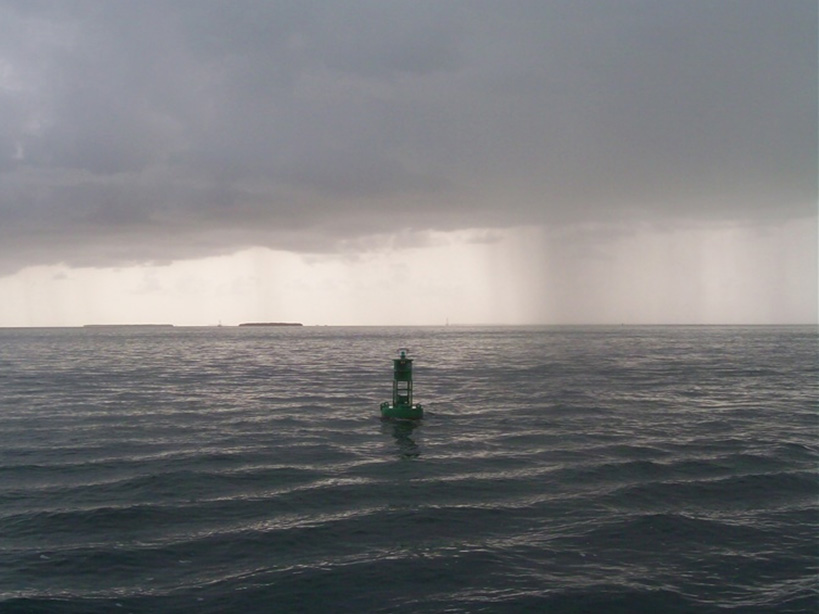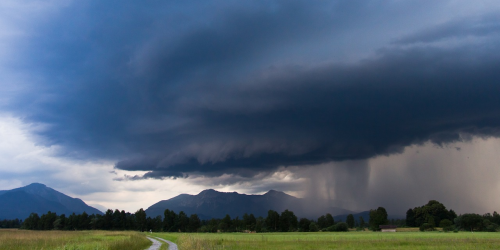CPO’s Climate Variability and Predictability (CVP) Program in partnership with NOAA’s National Weather Service – Office of Science and Technology (OSTI) Modeling Division are announcing ten new three-year projects in Fiscal Year 2022 (FY22) that aim to improve the understanding of precipitation processes and the representation of precipitation in weather and climate models. The competitively selected projects total $7.78 million in grants1.


During the past two years, NOAA has developed the Precipitation Prediction Grand Challenge (PPGC) Strategic Plan to help further align NOAA’s research efforts on improving precipitation skill. The goal of the initiative is to “provide more accurate, reliable, and timely precipitation forecasts across timescales from weather to subseasonal to seasonal (S2S) to seasonal-to-decadal (S2D) through the development and application of a fully coupled Earth system prediction model.” An important aspect of that effort is to gain a better understanding of ocean and atmospheric processes through data analysis, and global or regional modeling experiments, which target key model deficiencies that limit precipitation prediction skill.
In November of 2020, NOAA and the Department of Energy (DOE) jointly held a workshop (NOAA-DOE Precipitation Processes and Predictability Workshop) that identified that to accelerate progress in addressing precipitation biases and improving precipitation simulations and predictions across a broader set of phenomena and timescales, it is important to know practicable predictability limits and opportunities therein. Many model biases are due to inadequate representations of key physical processes (such as convection, aerosol-cloud interactions, coupling of atmosphere-, ocean-, sea ice- and land- boundary layer) in models. These biases and errors involve complex interactions, and feedbacks that deserves systematic examination.
In FY22, CVP and OSTI are interested in understanding, diagnosing and modeling of key processes for improving the simulation of subseasonal to seasonal (S2S) precipitation in weather and climate models. This timescale bridges the weather and climate continuum and is an expanding area of research interests in support of NOAA extended-range to seasonal operational forecast systems. Additionally, improving key processes associated with precipitation can provide benefits for information on timescales of weather through climate change.
More specifically, CVP and OSTI issued a call soliciting projects that address the topics described below:
- Focus Area A (CVP): Research that identifies and understands key processes that influence model biases and systematic errors in the simulation of precipitation at the subseasonal to seasonal (S2S) timescale
- Focus Area B (OSTI): Research to advance NOAA’s Unified Forecast System (UFS) prototype operational system for subseasonal to seasonal (S2S) prediction
The 9 new projects2 funded by the CVP Program (Focus Area A) in FY22 are:
- Diagnosing S2S Precipitation Biases and Errors Associated with Extratropical Cyclones and Storm Tracks over the Continental United States Using the GFDL SPEAR Model
Storms originating in the midlatitudes and over the Continental United States are the main source of precipitation during the winter in this region. A better understanding of the biases and errors in predicting their tracks, and understanding their relationships with climate drivers such as El Niño Southern Oscillation (ENSO), Madden-Julian Oscillation (MJO), polar vortex and the Quasi-Biennial Oscillation (QBO), can improve sub-seasonal to seasonal (S2S) precipitation prediction. This project will examine the origins of storm-related precipitation bias in NOAA Geophysical Fluid Dynamics Laboratory (GFDL)’s Seamless System for Prediction and Earth System Research (SPEAR) model and extend that knowledge to diagnose the Coupled Forecast System Model – Version 2 (CFSv2) and Global Ensemble Forecast System (GEFS) simulations.- PI: Edmund Kar-Man Chang, Stony Brook University
- Co-PI(s): Xiaosong Yang, NOAA/GFDL
- A Multiscale Diagnostics Hierarchy for Detecting, Source-Tracking, Understanding, and Reducing Model Biases in the US Warm Season S2S Precipitation Variability
In the Central United States, Mesoscale Convective Systems (MCS), which are a collection of individual thunderstorms that act as a system, are responsible for the majority of the precipitation during the summer. However, due to model biases in reproducing large-scale atmospheric processes, global climate models do not simulate MCS very well on a regular basis. As a result, simulating and predicting warm season precipitation across the sub-seasonal to seasonal (S2S) timescales becomes a major challenge. This project aims to reduce model biases and create a new framework to simulate MCS by targeting the processes of MCS initiation, growth and decay using GFDL’s Atmospheric Model 4 (AM4).- PI: Yi Deng, Georgia Institute of Technology
- Co-PI(s): Yi Ming, NOAA/GFDL
- Precipitation Biases along the Warm Pool Edge as a Cause of Poor El Niño Forecasts During Boreal Spring
El Niño Southern Oscillation is a major driver in weather and climate patterns around the globe. Accurate El Niño forecasts mainly rely on the interaction of warm ocean water and weather events that bring westerly wind bursts and strong precipitation to the tropical western and central Pacific Ocean. This project will use forecasts from the North American Multi-Model Ensemble (NMME) and Subseasonal Experiment (SubX) results, alongside ocean reanalysis and satellite data to assess the upper ocean’s response to strong precipitation and wind, how well forecast models capture that ocean stratification, and the role of these weather events in producing accurate El Niño forecasts.- PI: Kyla Drushka, University of Washington
- Co-PI(s): Aaron Levine, University of Washington, Michelle L’Heureux, Caihong Wen, NOAA/CPC
- Investigating the MJO-TC connection and its role in subseasonal U.S. precipitation prediction
Tropical cyclones (TCs) are a major source of extreme precipitation in tropical and subtropical regions and they also have associated precipitation in the Continental United States. The Madden-Julian Oscillation (MJO) is a storm pattern (e.g., disturbance of clouds, rainfall, winds, and pressure) that moves eastward around the planet near the equator. Research has shown that there is a relationship between MJO and TCs that plays a role in subseasonal precipitation prediction in the continental U.S. coastal and inland areas. Using the Unified Forecast System (UFS) model, the World Climate Research Programme (WCRP) sub-seasonal to seasonal (S2S) database, reanalysis and observations, this project will identify and understand model biases and systematic errors in the representation of this complex connection.- PI: Daehyun Kim, University of Washington
- Co-PI(s): Eric D. Maloney, Colorado State University; Suzana Camargo, Columbia University
- Dependence of MJO Precipitation Maintenance on Convective Processes
The Madden-Julian Oscillation (MJO) is a storm pattern (e.g., disturbance of clouds, rainfall, winds, and pressure) that is confined to the tropics. It circles the planet from west to east and returns to its starting point every 30 to 60 days. As such, it contributes to precipitation variability in the seasonal to subseasonal (S2S) timescales and influences precipitation in the midlatitudes. A few numerical models, including NOAA’s Global Forecast System (GFS) and Climate Forecast System (CFS), struggle to demonstrate skill in tropical rainfall in the S2S timescale. Specifically, there is a big discrepancy between the observed and modeled MJO-related convection over the Maritime Continent (MC). Using a combination of observations and numerical models, this project will identify the physical processes that are key to improving model representation of interactions between the diurnal cycle of rainfall and the MJO over the MC.- PI: Scott Powell, Naval Research Laboratory
- Co-PI(s): Ángel F. Adames-Corraliza, University of Wisconsin
- Exploring the physical mechanisms of the role of soil moisture, topography, and diurnal cycle of insolation on S2S precipitation in the Maritime Continent
The Maritime Continent (MC) is a region that plays a pivotal role in the global weather and climate system. It is located between the western tropical Pacific and the Indian Ocean. It is composed of several islands (e.g., Indonesian Islands, Malaysia) surrounded by shallow seas. In addition to serving as a key region in the globe’s climate, the MC acts as a predictability barrier for subseasonal-to-seasonal (S2S) prediction of precipitation. Currently, its land-atmosphere interactions are not well represented in weather and climate models, potentially causing errors in precipitation prediction skill. This project will use available observations, simulations, and model diagnostics to understand the physical processes that modulate S2S precipitation in the MC.- PI: Pallav Ray, Florida Institute of Technology
- Co-PI(s): Efthymios Nikolopoulos, Florida Institute of Technology. Collaborator: Nathaniel Johnson, NOAA/GFDL
- Understanding the diurnal rainfall processes over tropical islands to improve subseasonal to seasonal precipitation forecasts
The Madden-Julian Oscillation (MJO) is an important source of global subseasonal-to-seasonal (S2S) prediction skill, especially over the Maritime Continent (MC). Due to challenges in capturing the interactions between the region’s land masses and their diurnal cycle, current global models struggle with predicting the development of the Madden-Julian Oscillation (MJO). This project will assess the relationship between the representation of the diurnal cycle of rainfall in S2S models and the skill of these models to forecast tropical precipitation. The study will utilize data from forecast models (Global Ensemble Forecast System – GEFS, European Centre for Medium-Range Weather Forecasts – ECMWF), satellite (Climate Prediction Center morphing method – CMORPH, and the Integrated Multi-satellitE Retrievals for GPM – IMERG), and data collected from the Years of Maritime Continent (YMC) field campaign.- PI: Naoko Sakaeda, University of Oklahoma
- Co-PI(s): James Ruppert, University of Oklahoma; Giuseppe Torri, University of Hawaii at Manoa. Collaborators: Juliana Dias and George Kiladis, NOAA/PSL
- Analysis of the dynamical links between SST, boundary layer convergence, atmospheric fronts, and precipitation in the North Atlantic storm track
Standard resolution climate models (1-degree, up to ~110km or ~69 miles) may miss key aspects of processes that drive precipitation in the mid-latitudes, such as fronts and ocean features. The disconnect between these real-life processes and the simulated models creates a gap on longer-range and subseasonal-to-seasonal (S2S) predictability. This project will work to understand the linkages between sea surface temperature (SST), land surface convergence, and precipitation. The project will utilize high resolution datasets from various climate models (European Centre for Medium-Range Weather Forecasts/ECMWF Reanalysis v5 – ERA5; Climate Forecast System Reanalysis – CFSR; Community Earth System Model – CESM; High Resolution Model Intercomparison Project – HighResMIP), both remote and in-situ precipitation data (Integrated Multi-satellitE Retrievals for GPM – IMERG), and a recently developed boundary layer model.- PI: Justin Small, University Corporation for Atmospheric Research
- Co-PI(s): Lucas Cardoso Laurindo, University of Miami; Niklas Schneider, University of Hawaii at Manoa; Rhys Parfitt, Florida State University
- Explainable AI and Process Diagnostics to Understand State-Dependent Precipitation Forecast Errors
Errors in the simulation of subtropical and midlatitude circulations can introduce forecasts errors in U.S. precipitation via incorrect teleconnections. Furthermore, some weather and climate patterns such as the Madden-Julian Oscillation (MJO) are not always active, contributing to errors on an intermittent basis. This project will use novel explainable artificial intelligence (XAI) to identify, understand, correct via post-processing, and improve the UFS forecasts of North American precipitation at subseasonal-to-seasonal (S2S) lead times.- PI: Elizabeth Barnes, Colorado State University
- Co-PI(s): Eric Maloney, Colorado State University
The 1 new project funded by the NWS/OSTI/ Modeling Division (Focus Area B) in FY22 is:
- Using Model Evaluation Tools (METplus) to Evaluate Process Related Precipitation Skill and Biases in the NOAA Seasonal Forecast System (SFS) over North America to Improve Climate Prediction Center (CPC) Operational Seasonal Forecasts
Integrating the NOAA Unified Forecast System (UFS) Seasonal Forecast System (SFS) into the Climate Prediction Center (CPC) seasonal forecasts relies on the assessment of skill and biases of precipitation over North America. The Model Evaluation Tools (METplus) is the verification framework for all the UFS Applications and is currently being onboarded for operational use at CPC. It has been recently found that METplus requires more development to seamlessly integrate with seasonal climate data, such as UFS-SFS and the North American Multi-Model Ensemble (NMME). This project will enhance METplus capabilities to allow streamlined assessment of probabilistic seasonal precipitation forecast skill, including hindcast and conditional skill related to the key climate drivers within the UFS-SFS. The development, documentation, and demonstration of process-based model capabilities will provide valuable feedback to the UFS model development team and community, with the potential to improve the key modes of variability that impact seasonal precipitation forecasts.- PI: Ben P. Kirtman, University of Miami
- Co-PI(s): Tara Jensen, University Corporation for Atmospheric Research; Dan Collins, NOAA/CPC, Johnna Infanti (Innovim/CPC). Collaborators: Emily Becker, University of Miami/CIMAS), Justin Hicks (Innovim/CPC), John Opatz (NOAA/CPC).
1The funding will be distributed over the life of the projects and future-year funding is conditional on appropriations.
2 At the time of publication, all awards may not have been accepted by recipient institutions





